This week was my final week at OSU and I did a lot of work involving RC planes such as building, designing, and flying.
On Monday, we starting building the Biplane design that we had decided on last week. We started by building the fuselage, which we made by stacking three Styrofoam sheets and cutting them into our desired shape and hollowing out the middle sheet then rounding off the edges to make it more aerodynamic. We glued the middle panel to one of the side panels and left the other panel off so we could easily take the side panel on and off in order to access our wirings. During our building, several of the OSU students were cleaning up their workspace and scrapping unused planes. We asked if we could use some of the pieces that they were scrapping and they agreed, so we were able to salvage a tail piece. This would be helpful because we would not have to design a new tail piece which, helped us to save time in the building process. We then attached the tail piece to the fuselage using a carbon fiber rod. We finished off the day by adding our motor, servos, battery, and receiver to the plane.
(Inside of Fuselage)
On Tuesday, we continued our biplane build. We started by adding landing gear to the front of our plane. Adding landing gear was supposed to prevent the plane’s propellor from breaking during the landing process but in the end, they only managed to weigh the plane down and hinder its flight capability. While we were installing the landing gear, several of the OSU students were moving boxes out of the corner we were working in and behind one of the boxes that we moved was a very large spider which someone picked up in a box and put outside. We then added the wing to our plane and decided to fly it. Our original plan was to make a biplane but we really wanted to fly it so we went with one wing instead of two. After adding the final touches, we attempted to fly the plane but it only managed to glide across the ground and never fully took off. I believe that our plane was unable to fly because it was too heavy, had too weak of a motor, and had an improperly sized wing for its size. After our failed flight, we met with the director of USRI, Dr. Jacobs, and he asked us to incorporate an inflatable wing into our future redesign. Inflatable wings are useful because they can be compacted and stored so that they don’t take up that much space then inflated later in order to fly. These are currently being researched because they could prove useful on for flight on Mars, because Mars has a very thin atmosphere compared to Earth and consequently flight requires a wing with a much larger surface area in order to generate lift. So wings could be sent to Mars in a deflated state to save space then inflated to increase the surface area of the plane. We finished the day by planning on how we would incorporate our inflatable wing into our design.
(Styrofoam Plane First Flight) (Giant Spider)
On Wednesday, we tried to improve our design for the plane we crashed on Tuesday by decreasing weight and increasing motor power. We cut some of the weight out of our plane by cutting out some of the unneeded Styrofoam and decreasing battery size. We did not have the right piece to inflate the the inflatable wing so we built a model one out of foam board. In order to use foamboard, we had to laser cut it first which required a CAD design so we spent the rest of the day CADing the design for our wing.
On Thursday, we attached the model wing we had designed on Wednesday then added an improved version landing gear so we could take off from the ground. We attempted to fly it but it was unable to get off the ground. The reason it did not fly was because the rest of the plane was too small for the wing and the wing did not have a very good air foil. An air foil refers to the shape of a wing and how it catches the air to generate lift. Since we did not know much about air foils at that time, we had tried to replicate the shape of the air foil on our successful plane but because that plane was so small, the air foil was different from what is required for a larger plane. Because of this, we decided to redesign our whole plane in order to fit the inflatable wing we were given. We spent a long time designing a new plane that would fit better with the wing. The Solar Cell Project that we started on our first week was also finished by Nicco and Meghana and given a new paint job. I was glad to see that the box we had made for their project worked so well and made it into the final design.
(Styrofoam Plane with Model Wing) (Solar Cell Final Design)
On Friday, we began to work on the new design for our plane. One of the engineers at the lab recommended that we use an auto stabilization unit in our plane so that the plane would be able to fly smoother when we started flying it. Logan wanted to do the CADing and building and I wanted to do the electronics so I got to work learning how to use the stabilization unit and connect it to the plane. It was somewhat difficult because the software and electronics we were using were somewhat old but I was able to figure it out with a lot of help from some of the OSU students. Since the plane was not fully built yet, I tested the stabilizer on our original plane and it worked really well. The plane was able to figure out what orientation it was in and automatically adjust the flaps to correct its orientation and fly straight. After I left the lab for the last time, we went to Eskimo Joe’s for my last dinner. Eskimo Joe’s was a very popular restaurant that was recommended by a lot of residents so we decided that we had to go at least once.
(Wiring and Stabilization Unit) (Eskimo Joe’s Chili Cheese Fries)
On Saturday, I woke up at 4 AM in order to catch my flight home. I flew from the Stillwater Airport to an Airport in Dallas, Texas where I had an 8 hour layover. After waiting for hours in Dallas I was finally able to get on the plane and I made it home at 6 PM.
(Plane View)

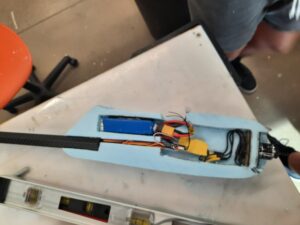
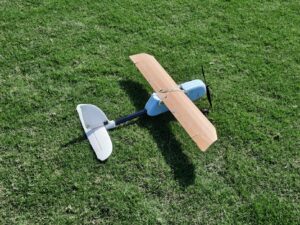
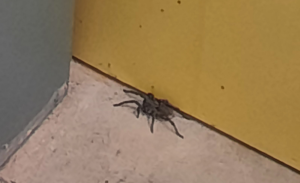
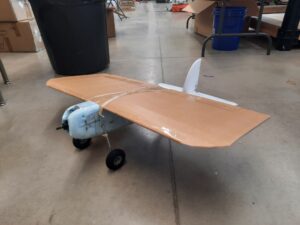
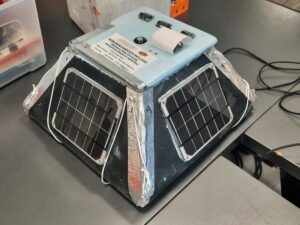
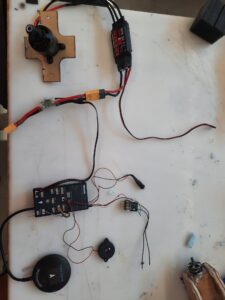
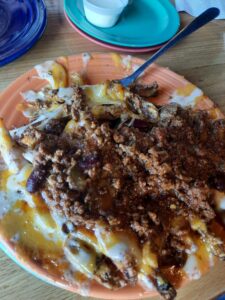
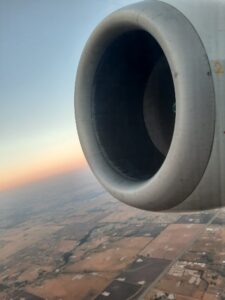
There are no comments published yet.